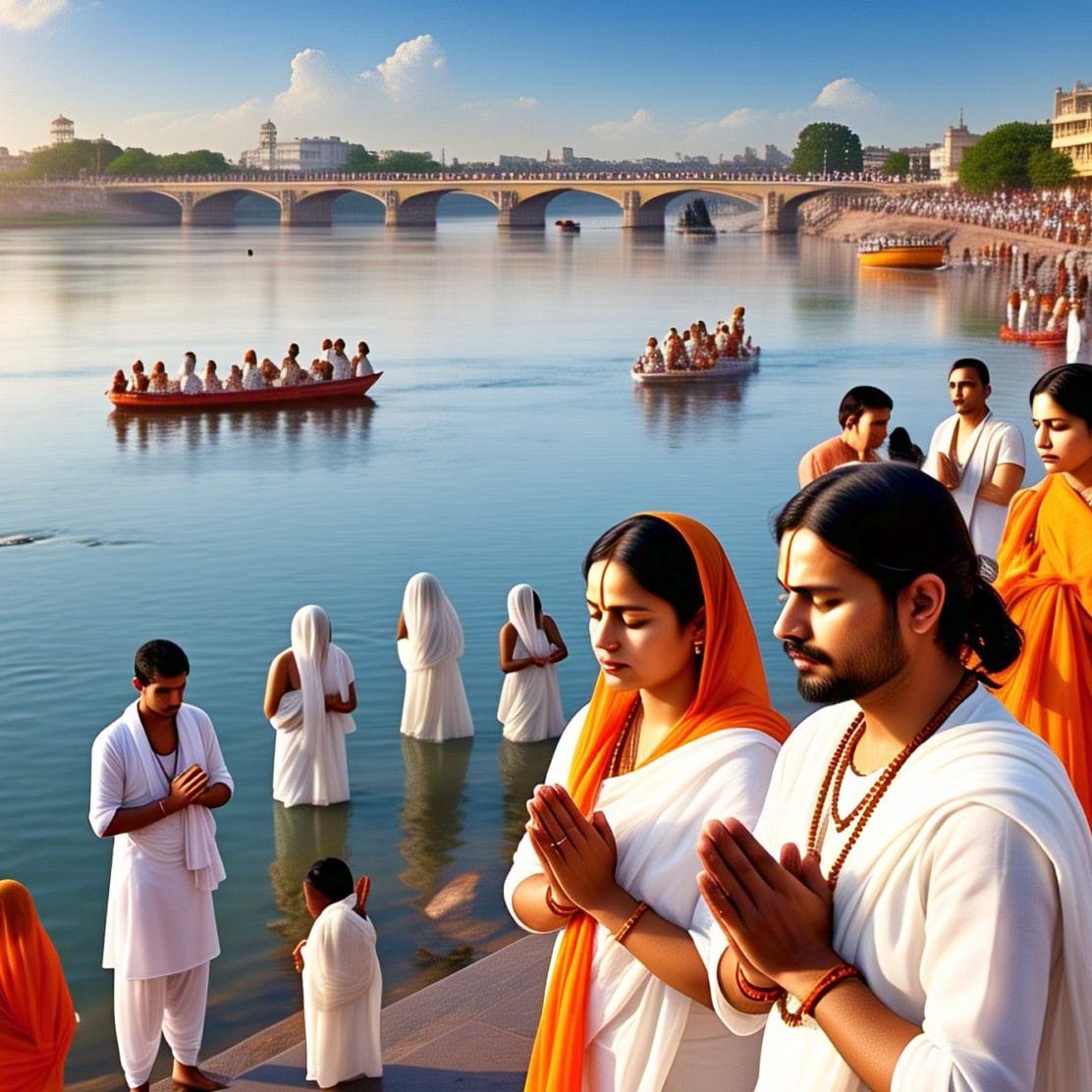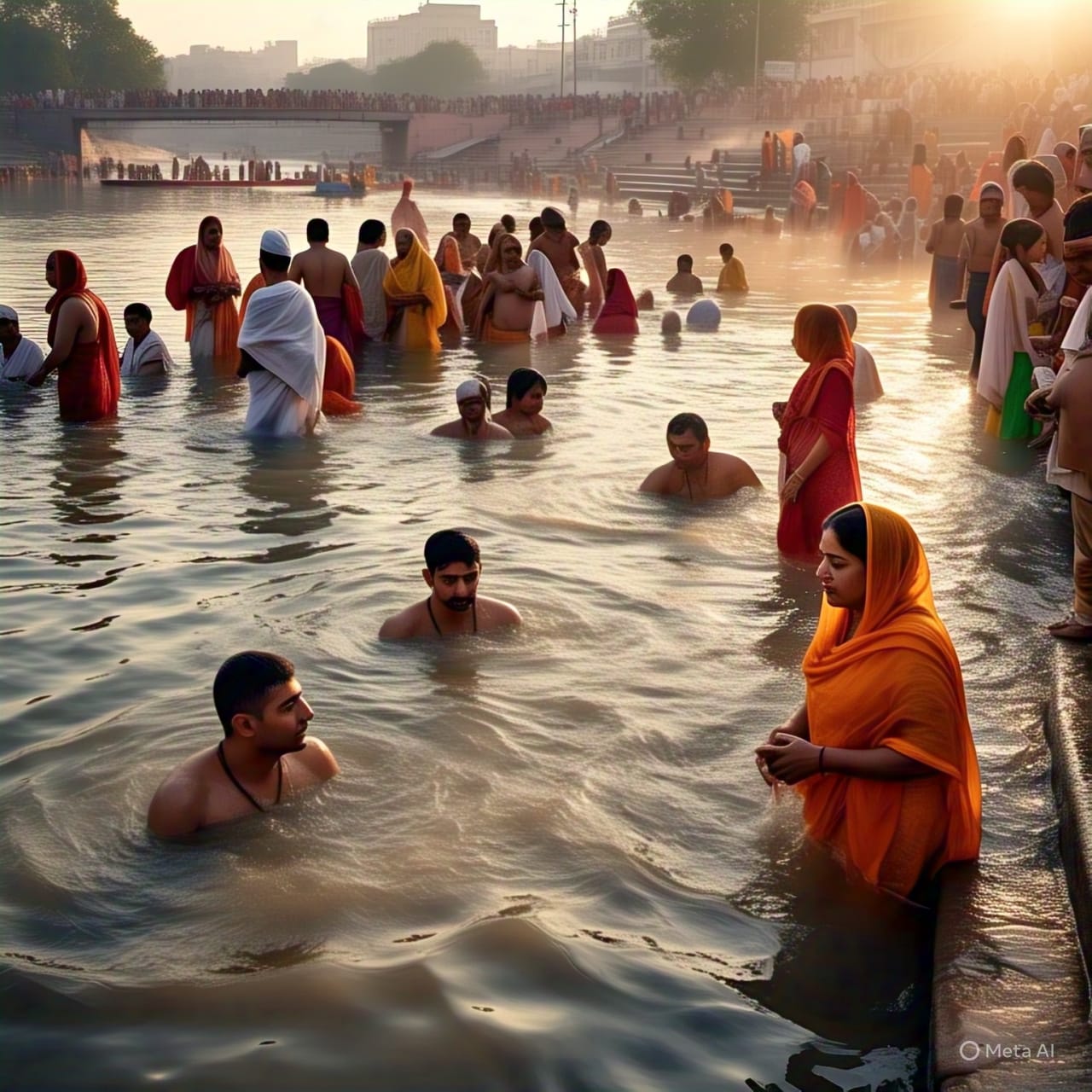Sacred Bath at Triveni Sangam
The Triveni Sangam in Prayagraj, where the sacred rivers Ganga, Yamuna, and the mythical Saraswati converge, is one of the most spiritually powerful places in India. Revered for centuries, this confluence is not merely a meeting point of rivers but a cosmic intersection of divinity, attracting millions of pilgrims who come to perform the ritual bath (snan) that is believed to cleanse sins, liberate the soul, and bestow moksha (salvation).
In this comprehensive guide, we explore the rituals, timing, beliefs, and deeper spiritual significance of the sacred bath at the Triveni Sangam — a practice woven deeply into the spiritual fabric of Hinduism.

Sacred Bath at Triveni Sangam
What is the Triveni Sangam?
The Triveni Sangam refers to the confluence of three rivers:
- Ganga – sacred, purifying, and motherly in essence.
- Yamuna – calm, serene, and symbolic of love and devotion.
- Saraswati – the invisible, mystical river said to flow beneath the surface, representing knowledge and wisdom.
Together, they form a trinity of spiritual forces, each representing a fundamental aspect of existence: purity, devotion, and wisdom. This makes Triveni Sangam one of the holiest places in India, alongside Varanasi, Haridwar, and Rameswaram.
The Spiritual Significance of the Holy Dip
The act of bathing at the Sangam is considered tirtha snan, a sacred pilgrimage act that washes away karmic sins and impurities.
1. Liberation from Past Sins
According to Hindu scriptures, bathing in the Triveni Sangam during auspicious periods is believed to:
- Erase all past sins (prarabdha karma).
- Break the cycle of rebirths (punarjanma).
- Lead to moksha or final liberation.
2. Blessings of the Deities
It is believed that:
- Ganga grants purity, washing away all negativities.
- Yamuna blesses the soul with emotional strength and devotion.
- Saraswati bestows wisdom, intuition, and spiritual insight.
3. Significance in Scriptures
- Mentioned in the Rigveda, Mahabharata, and various Puranas.
- Associated with gods performing yajnas and sages meditating at the confluence.
- Saints like Adi Shankaracharya, Tulsidas, and countless yogis have visited this sacred site.
Rituals Performed During the Sacred Bath
1. Sankalp (Vow-Taking)
Before entering the water, devotees take a sankalp (vow) by holding holy water in their palms and chanting mantras to declare their intent — be it for purification, ancestral blessings, or spiritual upliftment.
2. Snan (Bathing)
The devotee then wades into the water, preferably at the confluence point, and bathes while chanting:
“Har Har Gange” or “Om Namo Narayanaya”.
Some perform three dips, representing purification of body, mind, and soul.
3. Tarpan & Pind Daan
Devotees perform Tarpan — offering water and sesame seeds to deceased ancestors, praying for their peace. Pind Daan (offering rice balls) is also conducted to release souls from worldly bondage.
4. Arghya to the Sun
Offering water to Surya Dev (Sun God) during sunrise is an essential ritual. It symbolizes enlightenment, vitality, and inner awakening.
Best Time to Take the Holy Dip at Triveni Sangam
While the Sangam is sacred throughout the year, there are specific occasions when the spiritual power is magnified, making the bath especially auspicious:
1. Kumbh Mela (Every 12 Years)
The largest religious gathering on earth, attended by saints, sages, sadhus, and millions of pilgrims. Taking a dip during:
- Mauni Amavasya
- Makar Sankranti
- Basant Panchami is believed to yield divine merit a thousand times greater.
2. Magh Mela (Annual, Jan–Feb)
Held every year during the month of Magh (January–February). A month-long stay and daily bath in the Sangam is considered supremely meritorious.
3. Amavasya & Poornima
New moon and full moon days are considered spiritually charged. Bathing on these days is believed to help in ancestral liberation.
Pilgrim Experience: What to Expect at the Sangam
1. Boat Ride to the Confluence
Most pilgrims take a boat ride to reach the exact confluence point. The brownish Ganga, the greenish Yamuna, and the mythical Saraswati are said to meet visibly at a single point — a surreal and divine experience.
2. Pandits & Ritual Services
On the riverbanks, priests and purohits assist with rituals like snan, tarpan, rudrabhishek, and Ganga Aarti. Pilgrims often book ritual packages for guided ceremonies.
3. Ganga Aarti at the Banks
Every evening, a synchronized Ganga Aarti is held on the ghats, where devotees offer diya lamps, flowers, and incense to the sacred rivers. It’s a mesmerizing and spiritual closure to the sacred dip.
Preparation Tips for First-Time Pilgrims
- Reach Early Morning: Sunrise is the most serene and powerful time to take the dip.
- Dress Modestly: Wear traditional clothes (dhoti/saree/kurta). Changing rooms are available near ghats.
- Safety First: Use life jackets if boating; always stay near designated bathing areas.
- Carry Puja Essentials: Flowers, diyas, incense sticks, betel leaves, coconut, and ganga jal bottles.
- Respect Local Customs: Avoid photography during rituals and maintain the sanctity of the space.
Mythological Stories Connected with the Sangam
1. The Descent of Ganga
It is believed that Lord Shiva released the Ganga from his locks to flow across the Earth, purifying it. Her descent made the Sangam eternally pure.
2. Sagar Manthan Connection
The confluence is said to be connected to the churning of the ocean (Samudra Manthan), where sacred nectar fell at four places — Prayagraj being one of them.
3. Yajna by Brahma
Lord Brahma performed a yajna (fire ritual) here to establish divine balance, further sanctifying the site.
Cultural & Global Recognition
- UNESCO Intangible Cultural Heritage: The Kumbh Mela, held at Triveni Sangam, is globally recognized.
- Pilgrims from Worldwide: Hindus from Nepal, Mauritius, Indonesia, UK, USA, and more visit Prayagraj for this sacred bath.
- Film & Literature: The Sangam features in iconic Indian movies, poems, and travelogues, immortalizing its spiritual charm.
Final Thoughts: A Journey of Soul Purification
A sacred bath at Triveni Sangam is not just a religious ritual; it is a transformative journey — of humility, surrender, and rebirth. It’s where myth meets the present, where faith becomes action, and where the water holds the promise of liberation.
Whether you’re a devout pilgrim, a seeker of peace, or a lover of history and culture, the Triveni Sangam offers an experience beyond words — a chance to touch the timeless, if only for a moment.





